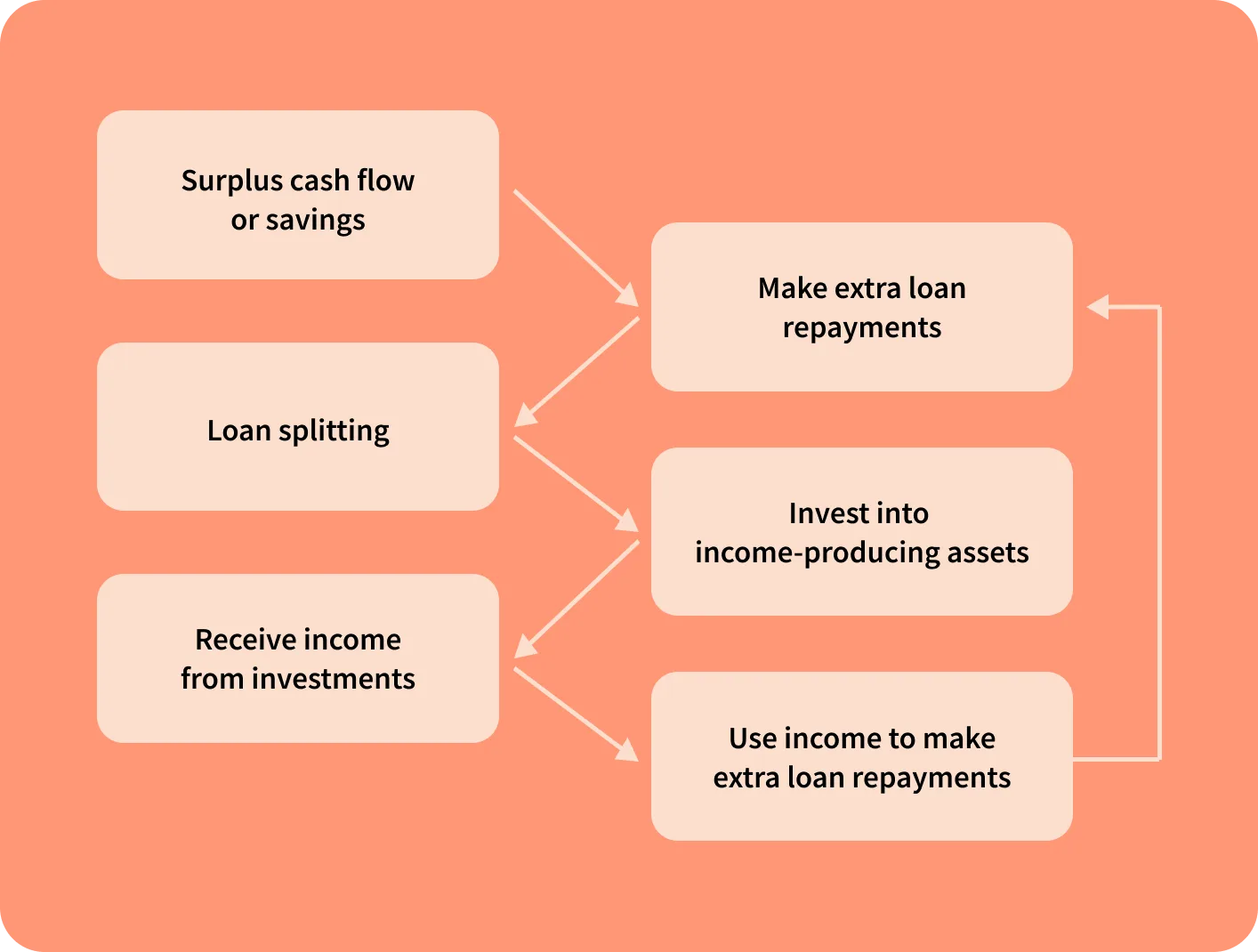So what is debt recycling and how do you do it without having ATO sniffing around?
Debt recycling is a strategy that aims to turn your non-tax-deductible debt (like your home loan), into tax-deductible debt (like an investment loan) over time. It involves gradually replacing your home loan with investment debt while building an investment portfolio.
Debt recycling vs equity release vs investment borrowing – what’s the difference?
What’s the difference between debt recycling and equity release? It can seem confusing, so let’s break it down.
Debt recycling converts existing home loan debt into deductible investment debt without increasing total debt.
Equity release and borrowing to invest (leveraging) both involve taking on additional debt to invest, which can amplify returns but also increase financial risk. The “recycle” name arises as you are not changing your overall debt position, but just converting from debt that does not have tax-deductible interest to debt that does have tax-deductibility.
Debt recycling checklist
Debt recycling may be appropriate for you if you:
- Have existing equity in their home
- Have a reliable and sufficient income to make additional repayments on their home loan
- Have a reliable and sufficient income to make additional investment loan repayments
- Are comfortable with investment risks and have a long-term investment horizon
- Aim to build wealth outside of superannuation
- Would like to be financially independent
How does debt recycling work?
In summary, debt recycling works by:
- Making additional home loan repayments (either regular or lump sum), generating available redraw that can be accessed for investment purposes
- Restructure your loan(s) (commonly known as loan splitting) so that the portion used for investment purposes is clearly separated from your home loan
- Invest: Use the borrowed funds to invest in income-producing assets (such as shares or ETFs)
- Repeat: Continue this cycle, gradually replacing your non-deductible debt with deductible investment debt.
Redraw vs offset
Most banks (and other loan providers) in the market offer the option of redraw facilities, and offset facilities. While both provide a reduction in the mortgage interest you are paying over time, there is a key difference between them when considering debt recycling.
When you make additional repayments via a redraw facility, the funds are treated as an extra repayment, and then “owned by the bank”. This means that when you use redraw, you are actually “borrowing” capital again.
While offset accounts reduce interest in a similar way, they’re not typically suitable for debt recycling because withdrawals from an offset do not constitute borrowing for investment purposes and will not create deductible interest.
Key Benefits vs Risks of debt recycling
| Benefits | Risks |
| Potential tax deductions on investment loan interest (good for high income earners) | Investment returns are not guaranteed and will fluctuate |
| Faster repayment of non-deductible debt (i.e. your mortgage is gone sooner) | You are increasing your debt levels and risk exposure (back to your original loan, in most cases) |
| Building a good investment portfolio outside super | Requires disciplined ongoing commitment to the strategy and record keeping |
| Build a share/ETF portfolio and hold property at the same time | Interest rate rises may affect how good the strategy |
| Potential for higher after-tax returns than your mortgage interest rate | Potentially reduced cashflow from investment loan repayments |
| Cashflow may improve over time from investment income | Potential for short-term investment returns to be below your mortgage rate |
| Benefits start small but grow rapidly over the long term | ‘Mixed loans’ can mean the interest is not tax deductible |
Key considerations before you begin
- Loan structure: It’s critical to have separate loan accounts for your home and investments to clearly distinguish between deductible and non-deductible debt (e.g. when you debt recycle you often end up with a bunch of small loan accounts from each time you recycle).
- Fees: Confirm with your bank if there are any fees incurred in the loan splitting process.
- Investment selection: Your investment strategy and selection should be appropriate to your risk tolerance, financial goals… and you still need to invest well!
- Professional advice: Appropriate advice from an accountant, mortgage broker and financial advisor will ensure the strategy suits your circumstances and is implemented correctly (the cost of the advice should pay for itself!).
- Record keeping: Maintaining detailed records of all transactions (investment and loans) to ensure tax deductibility – eventually the ATO might come knocking.
Potential Mistakes
- Mixed loans: Using the same loan account for personal and investment purposes can complicate tax deductions (and may ruin the whole strategy). Once a loan is combined, it is hard to unwind. Get a good mortgage broker.
- Tracing of borrowed funds: To maintain tax-deductibility, funds should be drawn directly from the investment loan into the investment account (and invested). Mixed funds or delays in investing could create complications. Some people use separate brokerage accounts for their debt recycled portfolio.
- Lack of emergency funds: Not having an adequate emergency buffer may mean that you have to sell investments at an inopportune time.
- Over-leveraging: Taking on too much debt without considering the risks can be significant and set you back many years.
- Inappropriate investments: You must ensure that the investments purchased are ‘income producing’ for tax-deductible purposes, but also that they are likely to generate enough ‘total return’ to outperform your mortgage rates over a long time horizon.
Debt recycling flowchart
After you ensure your bank has redraw available, and the ability to restructure into split loans (not all of them do this), then:

Scenario 1 – lump sum investment
James has a $500,000 home loan and $100,000 in savings that he would like to invest. Instead of investing the $100,000 directly, he makes an additional repayment of $100k into his home loan, reducing the non-deductible debt. He then splits his loan into two parts, one loan of $400k, and one loan of $100k (with the redraw still available).
Once the loan is split, James withdraws the $100k of redraw and uses this to invest into income-producing assets. The interest on this $100k loan is now tax-deductible, and any returns from the investment can be used to make additional repayments on the remaining $400k of non-deductible debt.
Scenario 2 – regular surplus cashflow
Jessie does not have additional savings to invest, but does have significant cashflow she would like to invest. Rather than investing straight into a diversified portfolio, Jessie makes additional loan repayments of $1,000 per week. After 1 year, Jesse chooses to loan split $52,000, then withdraws this to invest into a portfolio of income-producing assets, including shares and ETFs. Another year later, Jessie creates a third loan split, redraws $52k again and invests another $52k into income producing assets. Jessie now has the same amount of total debt, but $104k is tax-deductible after two years.
Reach out if you have any questions
If you have any questions about debt recycling it is essential that you ask questions and get expert answers before you begin. Structuring the loans wrong, getting a severe cashflow squeeze, picking the wrong investments, getting stung by the ATO when you incorrectly transfer money or follow the strategy… all of them could unwind the benefits of debt recycling.
So please get advice.I help a lot of my clients do debt-recycling and pursue financial independence. So if that sounds good to you, reach out to me by booking in a free call (ask for James). Otherwise, use our free 24/7 investor community to get quick responses to your questions.



